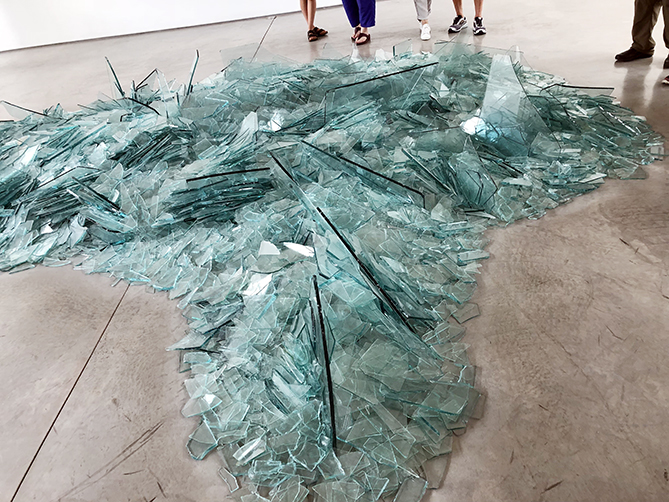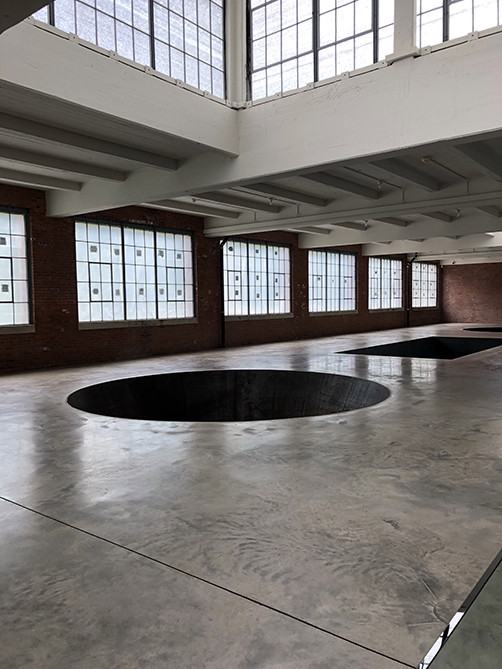On the banks of the Hudson River in Beacon, New York, is the DIA:Beacon (pronounced dee-ah) Museum, a former Nabisco box-printing facility turned gallery. Dia:Beacon is a museum located in Beacon, New York, and is part of the Dia Art Foundation, which is a contemporary art foundation. The term “Dia '', which was taken from the Greek word “through”, exemplifies the organization’s goal of enabling large scale projects (Dia). Renovated by artist Robert Irwin and architects including Alan Koch, DIA:Beacon presents its permanent collections, and occasional temporary exhibitions. The famed museum also promotes public interests through its monthly Gallery Talks, and serves the surrounding community with its Community Free Days. In total, the museum covers 160,000 square feet, making DIA:Beacon one of the largest modern art exhibition spaces in the United States. Therefore, it does not come as a shock that Dia has more exhibition space than Manhattan’s MoMA (Museum of Modern Art), Guggenheim, and Whitney combined.
For a first-time visitor, it is the exterior and surrounding environment of the facility that captivates his attention. DIA:Beacon lies next to ninety acres of riverfront parkland, showcasing contrast between serene greenery and harsh industry. The doors at DIA open upward to the parkland where gallery-goers socialize and engage in passionate conversations about art. Immediately upon entering the property, one’s breath is taken away by the endless array of olive green trees. Then he sees the building itself, a huge factory building. However, it is this sheer contrast and the captivating art housed in it that mesmerize art fanatics.
At the heart of the exhibition are the awe-inspiring light installations, also known as the heart of the Dia:Beacon. One of the most stunning among those is the works of Dan Flavin, an American artist known for his work with fluorescent lights. The work “Untitled (to a man, George McGovern) 2”, reveals a different hue depending on the direction that the viewer is facing. Whereas from the front one would spot the angelic white circles, from a further distance, one finds himself immersed in the vibrant mixture of the pink, green, and yellow. It is a surreal experience.

Another remarkable artist displaying art in the center is Robert Smithson, whose “Map of Broken Glass”, a work of art that imagined the Atlantis, captivates viewers with wonder. The transparent blue glass that looks as if it is about to fly away, compels one to ponder upon the artist’s intentions. The Atlantis is an enigmatic combination of the artist’s imagination and the artistic medium, transparent broken glass.

Lastly, the “North, East, South, West” by land artist Michael Heizer is a stunning end to the exhibition, making some linger for a long time lost in thought. The negative space art, brought to life by Heizer, is a conceptualized representation of the earth we live in. The artificial abyss measures about 20ft in depth, and 125ft in width. Museum director Michael Govan says, “The fact that the sculpture literally displaces the floor on which the visitor walks creates a sense of potential physical danger that further challenges the viewing experience.” Ultimately, the magnitude and intrinsic nature of the art itself evokes hypnotic emotional responses in those who experience it.

Whether one is a tourist or an art mogul, those who visit DIA: Beacon cannot fail to become smitten with art. It is an experience not to be missed.

Jong-a Isabelle Lee
Freshman (Grade 9)
Seoul International School

